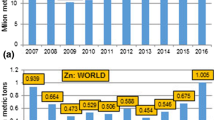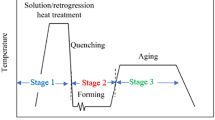Summary
The variation of alloying elements within a certain standard induces a severe modification of metallographic characteristics. This has an effect on the material behaviour, such as precipitation hardening, machining or anodization. The impact of element variation or element combination in individual alloy specifications is still a focal point of materials research. The influence of element variations and substitutions on material properties is discussed on the basis of alloy development and technology optimization of lead-free machining alloys. Present investigations have shown that tin as a lead substitute provides the required machinability and impairs the anodization behaviour only marginally. Examination of the precipitation behaviour after solution heat treatment and quenching confirmed the cause of an incubation time during natural ageing. The addition of medium copper contents with approximately 2.7 % Cu enables the compromise between adequate alloy strength and good machinability as well as acceptable anodization ability. Higher manganese concentrations assist the machinability, whereas the magnesium content should lie at the lower limit of the standard. Manganese additions cause a minimal strengthening, while the tensile strength is increased strongly.
Zusammenfassung
Die Variation der Elementgehalte innerhalb einer Legierungsnorm erlaubt eine starke Veränderung der metallographischen Charakteristika. Diese wirken sich direkt auf das Materialverhalten wie die Ausscheidungshärtung, die mechanische Bearbeitbarkeit oder die Eloxierbarkeit aus. Welche Effekte die verschiedenen Elemente oder Elementkombinationen in den einzelnen Legierungssystemen haben, ist nach wie vor ein zentrales Thema der Werkstoffforschung. Anhand der Legierungsentwicklung und Technologieoptimierung an bleifreien Automatenlegierungen sollen die Auswirkungen von Elementvariationen und -substitutionen auf die Materialeigenschaften verdeutlicht werden. Bisherige Forschungen zeigten, dass Zinn als Bleisubstitut die geforderte Zerspanbarkeit gewährleistet und nur geringfügig das Eloxierverhalten verschlechtert. Untersuchungen hinsichtlich des Aushärteverhaltens nach erfolgtem Lösungsglühen und Abschrecken bestätigten das Hervorrufen einer Inkubationszeit bei der Kaltauslagerung. Der Zusatz von mittleren Kupfergehalten mit ca. 2,7 % Cu erlaubt einen Kompromiss zwischen ausreichend hoher Legierungsfestigkeit und guter Zerspanbarkeit sowie akzeptabler Eloxierbarkeit. Höhere Mangan-Konzentrationen fördern die Zerspanbarkeit, wohingegen der Magnesiumgehalt an der Untergrenze des Legierungsfensters liegen muss, um die Spanbarkeit nicht negativ zu beeinflussen. Mangan-Zusätze bewirken einen minimalen Festigkeitszuwachs, während mit steigendem Magnesiumgehalt die Zugfestigkeit stark erhöht wird.
Similar content being viewed by others
Literaturverweise
Smolej, A., et al.: Properties of aluminium free-cutting alloys with tin, Part I&II. Aluminium 78 (2002) 4, 284–288 and Aluminium 78 (2002) 5, S. 388–391
Zoller, H., Enzler, G. and Fornerod, J.C.: Über die Zerspanbarkeit von Aluminiumlegierungen. Aluminium 45 (1969), S. 49–54
Sircar, S. and Subhasish, S.: Free-machining aluminum alloy and method of use. Reynolds Metals Company, Richmond, VA, US Patent No. 6,315,947 (2001)
Hasking, G.J. and Duggan, J.M. : Encephalopathy from bismuth subsalicylate. The Medical Journal of Australia 2 (1982) 4, 167
Koch, S.: Investigations of lead-free aluminium alloys for machining. Ph.D. Thesis, Montanuniversitaet Leoben, Austria, 2010
Koch, S., and Antrekowitsch, H.: Effects of varied Sn and Cu content in lead-free Al-Cu based alloys intended for free machining. Proc. of Conference of Metallurgists COM 2010, Vancouver, Canada, S. 289–298
Koch, S. and Antrekowitsch, H.: Free-cutting aluminium alloys with tin as substitution for lead. Berg- und hüttenmännische Monatshefte: BHM 153 (2008) 7, S. 278–281
Ostermann, F.: Anwendungstechnologie Aluminium. 2nd edition, Springer-Verlag, Berlin 2007. Kapitel 3–5 bzw. 14
Gottstein, G.: Physikalische Grundlagen der Materialkunde. 3. Auflage, Springer-Verlag, Berlin 2007, Kapitel 6 bzw. 9
Guinier, A.: La Diffraction des rayons X aux très petits angles: application à l'étude des phénomènes ultramicroscopiques. Annales de Physique 12 (1939), S. 161–237
Mondolfo, L.F. Aluminum Alloys: Structure and Properties. Butterworths, London 1976, S. 68–725
Abis, S. et al.: Early aging mechanisms in a high-copper AlCuMg alloy. Scripta Materialia 45 (2001), S. 685–691
Tsangaraki-Kaplanoglou, I.: Effect of alloy types on the electrolytic coloring process of aluminium. Surface and Coatings Technology 200 (2006) 12–13, pp. 3969–3979. –
Johne, P.: Handbuch der Aluminiumzerspanung. Aluminium-Verlag, Düsseldorf 1984, S. 21–88
Stulíková, I., Faltus, J. und Smola, B.: Influence of composition on natural ageing of Al-Mg-Si alloys. Kovove Materialia 45 (2007), S. 85–90
Hardy, H.K.: The aging characteristics of ternary aluminium-copper alloys with cadmium, indium, or tin. Journal of the Institute of Metals 80 (1951–52), S. 483–492
Edwards, B. J. and Scott, G. D.: Alcoa's UltrAlloy 6020: A lead free aluminum alloy with A-rated machinability ideally suited for precision machined parts. Alcoa (2004)
Author information
Authors and Affiliations
Corresponding author
Rights and permissions
About this article
Cite this article
Koch, S., Antrekowitsch, H. Auswirkungen von Elementgehaltsvariationen in Al-Knetlegierungen hinsichtlich Aushärtbarkeit, Eloxierbarkeit und Zerspanbarkeit am Beispiel von neuen bleifreien Al-Cu-Automatenlegierungen. Berg Huettenmaenn Monatsh 156, 443–449 (2011). https://doi.org/10.1007/s00501-011-0034-z
Received:
Accepted:
Issue Date:
DOI: https://doi.org/10.1007/s00501-011-0034-z




